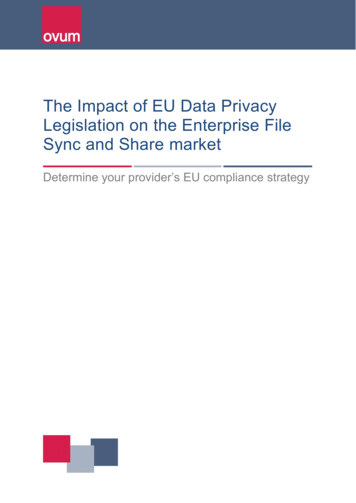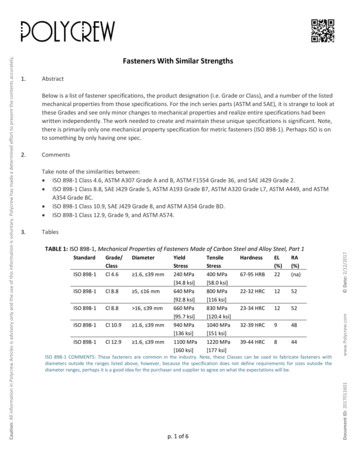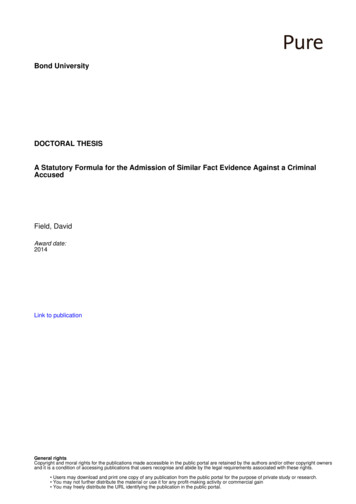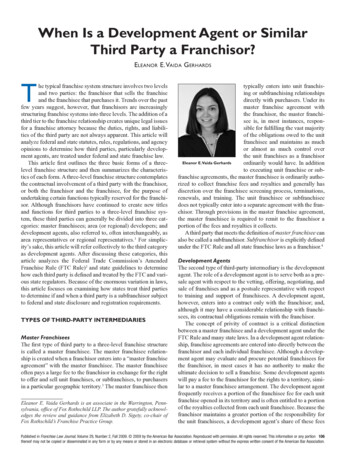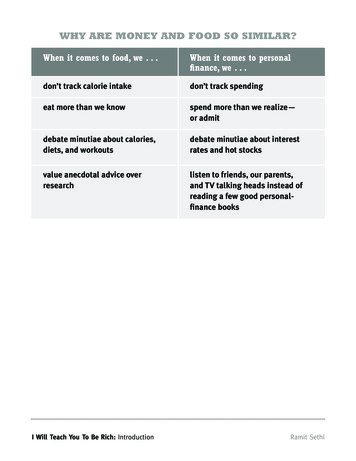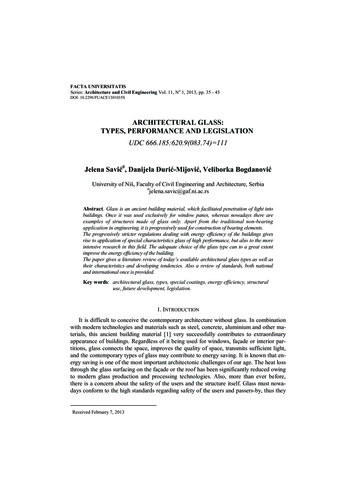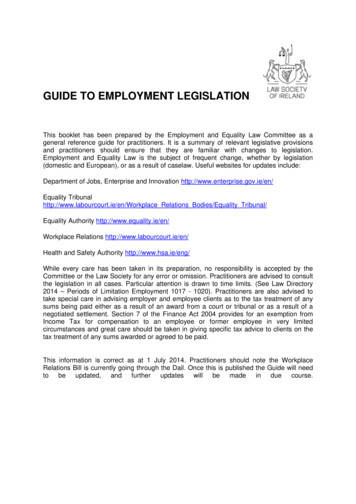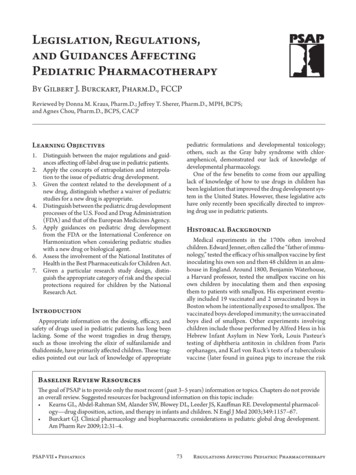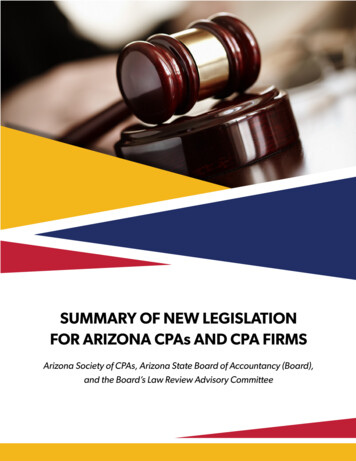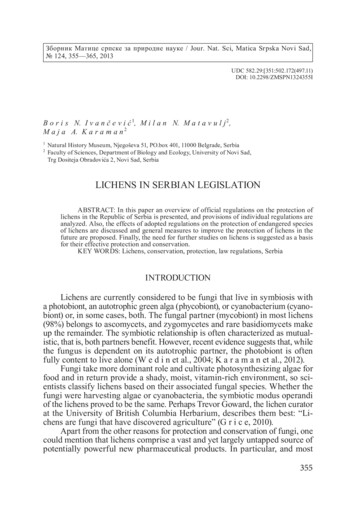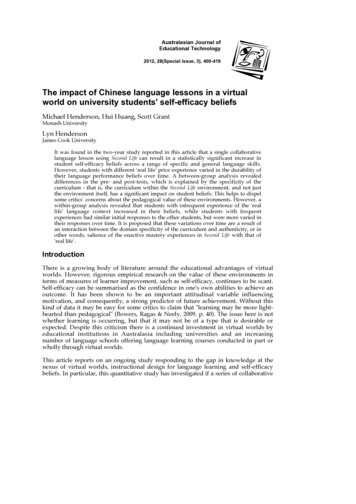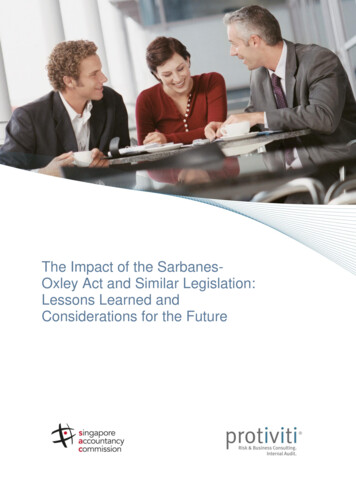
Transcription
The Impact of the SarbanesOxley Act and Similar Legislation:Lessons Learned andConsiderations for the Future
Protiviti, together with the input of the Singapore Accountancy Commission, has developedthis point of view (POV) on the impact of the Sarbanes-Oxley Act (SOX) and similarlegislation in Japan and China. Drawing upon Protiviti’s extensive experience in jurisdictionslike the United States, Japan and China, this POV examines the corporate environmentswhere strict rules were introduced through the implementation of SOX or similar legislation,the impact on internal controls of financial reporting to improve the accuracy and reliability ofcorporate disclosures and considerations for the future.Against this backdrop, this POV will share practical tips and guidance learned from Protiviti’sexperience in assisting companies with implementing the COSO Internal Control –Integrated Framework for compliance with the requirements of SOX and similar legislation.To complement these, discussions on SOX requirements in the United States, similarrequirements in Japan and China, value propositions of SOX and similar legislation, and thecost-benefit analysis of compliance, will also be included.It is hoped that this POV will provide the appropriate lessons learned from SOX and similarlegislation that can be used in evaluating practical and cost-effective ideas for continuallyimproving corporate governance and attracting foreign investments in Singapore.An Important ObservationSOX and similar requirements are a part of the total fabric driving reliable financial reporting,impacted by securities laws and regulatory oversight, exchange listing requirements,accepted accounting principles, effective auditing standards, accounting firm oversight,effective standards for audit committees of boards, and independence requirements fordirectors and auditors, among other things. They augment the existing regulatory,governance and reporting structure and must be designed taking into consideration otherlegislation, rules and regulations that establish responsibility and accountability for reliablefinancial reporting.I. Introduction of SOX Legislation RegimesIn the aftermath of the Enron era, several countries have enacted legislation aroundevaluating financial reporting controls, which require management to assess internalcontrols, but not the company’s external auditor. Some countries have adopted a “comply-orexplain” approach to management assessment, while others have issued corporategovernance codes that recommend having a management assessment. Few countriesrequire attestation by the external auditor, yet both the United States and Japan require anauditor attestation of internal control, while in China only management assessment ofinternal control is required.United StatesThe United States enacted the Public Company Accounting Reform and Investor ProtectionAct (as titled on the Senate version of the bill) to improve public and financial reporting,commonly referred to as the Sarbanes-Oxley Act of 2002 or “SOX.” The introduction of USSOX has spawned legislation with similar goals in other countries, most notably Japan andChina. Of the numerous provisions of US-SOX, Sections 302, 404 and 906 requirecertification of financial statements and other financial information as well as an assertion ofthe effectiveness of internal control over financial reporting (ICFR) by a company’smanagement. In addition, Section 404 requires the issuer’s independent auditor to expressan opinion on the effectiveness of ICFR as part of an integrated audit, i.e., the audit of ICFRis integrated with the audit of the financial statements. Please refer to the Appendix Part I fora more detailed discussion on the requirements of these provisions.1
JapanJapan’s version of SOX is incorporated in its Financial Instruments and Exchange (FIE) Actenacted in 2006. In applying this law, the Subcommittee on Internal Controls of the BusinessAccounting Council issued its “Evaluation and Auditing Standards for Internal Control forFinancial Reports” and “Implementation Standards,” both of which were finalized in 2007.The Law and Standards are collectively referred to as Japanese SOX or J-SOX, and applyto companies listed on Japanese exchanges. For the Standards’ description ofmanagement’s evaluation and the audit of ICFR, please refer to the Appendix Part I. TheseStandards require management to develop and operate internal controls, evaluate theireffectiveness and report the results in an internal control report to the public. The externalauditor is also required to audit management’s evaluation of the effectiveness of internalcontrol for financial reports.While similar to US-SOX in many respects, there are some important differences in J-SOXthat affect the process and, ultimately, the costs of conducting the management assessmentand the external audit of internal controls. These differences pertain to the assessmentscope for process-level controls and alignment of this scope between the external auditorand management, as well as the external auditor’s focus (i.e., the audit is focused on theappropriateness of management’s evaluation versus the effectiveness of internal control).These requirements are elaborated in greater detail in the Appendix Part I.ChinaThe China stock exchanges (Shanghai stock exchange and Shenzhen stock exchange)released requirements on the disclosure of the internal control self-assessment results bylisted companies in 2006. However, these were not strictly implemented due to variousreasons, one of which is the lack of a common standard for assessing internal controls.Consequently, the self-assessment results brought out by companies were neitherconvincing nor comparable.Later, the promulgation of the Basic Standard for Enterprise Internal Control (the Standard)in 2008 and the related series of supplemental guidelines (the Guidelines) in 2010 improvedthe feasibility of the stock exchanges’ requirements regarding internal control selfassessment through providing generally accepted rules for the assessment of internalcontrol effectiveness. Together, the Standards and Guidelines are sometimes referred to asChinese-SOX (C-SOX), which require management to undertake an annual self-assessmentof internal control effectiveness and disclose the conclusion in an annual report, and apply tolisted Chinese companies. Unlisted large and medium-sized Chinese companies are alsoencouraged to adopt the rules.II. Value Proposition of SOX ComplianceWhen evaluating the value proposition of SOX, there are several related questions:1. What is really accomplished by complying with SOX or similar regulations, i.e., what arethe direct benefits?2. Can a controls assessment accomplish more than complying with SOX or similarregulations, i.e., are there any indirect benefits?3. What are the costs of SOX or similar regulatory compliance?Answers to these questions will vary by country depending on what is required and whetherimplementation is effective. In this section of the POV, we will focus on the benefits side ofthe equation. Costs will be addressed in a subsequent section.2
United StatesBelow are some direct and indirect benefits of compliance with US-SOX, based on theresults of several studies. Please refer to the Appendix Part II for further details on theseresults. More Reliable Financial Reporting Reduced Financial Statement Restatements Improved Stock Price Performance Reduced Cost of Capital Continuous Improvement of Internal Processes and Control StructureJapanThe results of an April 2013 survey by Protiviti of 175 Japanese companies on the benefitsand costs of complying with the internal control-related requirements of the FIE Law andSection 404 of US-SOX showed that the following benefits were obtained through SOXcompliance: Deeper understanding of what controls are in place and how they are operated Improvement in the effectiveness and efficiency of operations (e.g., process and controlautomation) and the further identification of duplicate and redundant controls Opportunity for enhancing internal audit in the areas of operational efficiency and nonfinancial reporting by leveraging the knowledge and experience gained through the SOXcompliance.The results are explained in further detail in Appendix Part II.ChinaAfter several years of C-SOX practice, Chinese companies’ management are starting torealize the value of establishing and enhancing internal control systems, and have startedinitiatives in internal control development rather than passively complying with C-SOX.These were observed in more non-listed companies as well. Chinese companies havebenefitted from implementing internal control systems under C-SOX in several ways,including, among others, improvement in the effectiveness of corporate governancestructure to better support management in decision-making, enhanced efficiency indeploying resources to priority risk areas and streamlining of processes.III. SOX and COSOIn the United States, the Securities and Exchange Commission (SEC) ruled that the criteriaon which management’s evaluation of ICFR is based must be derived from a suitable,recognized control framework that is established by a body or group that has followed dueprocess procedures, including the broad distribution of the framework for public comment.The SEC points out in its rules that the COSO Internal Control – Integrated Framework(COSO Framework) is a “suitable framework,” and acknowledges that frameworks otherthan COSO that satisfy the intent of the statute without diminishing the benefits to investorsmay be developed within the United States in the future. Other frameworks in other countriesmay also meet this requirement. Please refer to the Appendix Part III(a) for morebackground on the COSO Framework.3
Relating the COSO Framework to ICFRThe COSO Framework depicts the interrelationship among an organization’s objectives, thecomponents of internal control, and the operating units, legal entities and other structureswithin the entity. Applied to ICFR, it emphasizes the importance of management’s judgmentin evaluating the effectiveness of a system of internal control. Determination of effectivenessis a subjective judgment resulting from assessment of whether (1) each of the fivecomponents of internal control (as reflected in the COSO Framework) is present andfunctioning and (2) the five components operate together to provide “reasonable assurance”that the relevant objectives are met. The Framework facilitates this exercise of judgment byproviding a total of 17 principles for the five components, upon which management exercisesjudgment to determine the extent to which they are present and functioning in evaluatingwhether the components to which these principles relate are present and functioning.Appendix Part III(b) demonstrates how the Framework is applied to assessing the riskrelating to reliable financial reporting arising from management fraud through an override ofinternal controls.IV. Results of SOX ComplianceAppendix Part V provides details on studies conducted on the results of SOX compliance. Ageneral improvement trend was noted across the United States, Japan and China.United StatesAn Audit Analytics study1 which summarized SOX results for the first six years sinceSection 404 went effective demonstrated the improvement in ICFR over these first years ofSOX compliance in the United States, as well as a marked improvement regarding thepercentage of adverse SOX 404 filings implicating a deficiency in a company’s segregationof duties.JapanSince the inception of J-SOX in the financial year ended March 2009, it has consistentlybeen the case that only a small proportion of Japanese companies reported materialweaknesses in their internal control systems; and this proportion is getting even smaller,reflecting the improvement and enhancement of internal controls that have taken place overthe last five years.ChinaImplementation of C-SOX has elevated the importance of financial reporting controls in theeyes of Chinese executives.V. Practical Tips for Implementing the COSO Framework and Complying withSOX RequirementsProtiviti assists many companies with complying with SOX regulations and/or implementingthe COSO Framework, which include listed companies as well as private companies withaspirations for going public. They also include companies of different size and scale and atdifferent levels of internal control maturity. This section illustrates some practical tips andlessons learned that have surfaced over the years, based on our observations in assistingthese companies. More details are available in the Appendix Part VI.United StatesWith SOX Section 404 in play since 2004, much has been learned about what to do andwhat not to do.1 “SOX 404 Dashboard: Year 6 Update,” Audit Analytics , October 2010.4
Use a top-down, risk-based approach – The first three years of Section 404compliance was marred with attention to low risk areas due to a lack of standardsdirected to issuers. The SEC issued interpretive guidance to issuers in 2007 thatpromoted efficiency by allowing management to focus on those controls, i.e., “keycontrols,” that are needed to adequately address the risk of a material misstatement ofits financial statements through a top-down, risk-based approach. Likewise, the PublicCompany Accounting Oversight Board (PCAOB) issued its Auditing Standard No. 5 toencourage this approach. Apply project management concepts – As they gained experience, companieslearned specific lessons in making the compliance process more effective in applyingproject management concepts to ensure achievement of key milestones and deadlines.More importantly, companies understood the need for top management support to beable to succeed, and involvement of external auditors at appropriate points during theprocess to align risk assessment considerations in order to maximize audit costeffectiveness. Leverage on internal audit – To address the resource constraints issue so common tomany companies in the first year of Section 404 compliance, internal audit proved to be apotential source of resources in documenting and testing internal controls, and providinginput to management with respect to concluding on design and operating effectiveness.The COSO Framework also points out that separate evaluations conducted by internalaudit serve as a form of monitoring.JapanThe J-SOX experience offers some valuable lessons on mitigating costs of compliance forregimes considering SOX-like requirements. Based on companies surveyed, somemeasures that could similarly be applied include: Reliance of external auditors on the testing performed by companies – An increasein the external auditors’ reliance on the testing performed by companies is beneficial forcompanies in improving the efficiency of the external audit process and raising thequality level of both internal controls and internal audit to meet the external auditor’sexpectations. Use of control self-assessment – Self-assessment methodologies facilitate allocationof the control testing workload more evenly across the company and encouragecommitment of process owners to maintain and improve internal controls. Exclude certain business locations from the scope of testing – Revisions of the JSOX requirements now allow a rotation approach, i.e., companies may exclude abusiness location (such as a branch, a division and a subsidiary) from the scope ofprocess-level controls testing, provided its controls were tested to be effective in theprevious year with no significant changes in their design.Further rationalization can be achieved by focusing on business locations where thepossibility of control failure is relatively high, which can be a noteworthy point forstreamlining compliance costs over the years. Relying on the control operating effectiveness test results of the previous year –Revised J-SOX requirements also allow companies to rely on the results of testingoperating effectiveness from the previous year for process-level controls to focus theoverall testing effort on those controls with greater importance or with a greaterpossibility of failure, except for those controls considered to be of material importance inensuring the reliability of financial reporting.5
ChinaProtiviti’s experience with C-SOX shows that there is no “one size fits all” model of aninternal control system that can be easily adopted and which still complies with C-SOXrequirements. Despite that the Standards and the Guidelines are explanatory andmeticulous, the internal control system of each company needs to be designed withconsideration of management’s assessment of the risks, costs and benefits, and thatassessment should be integrated effectively with existing policies and procedures.VI. SOX Compliance CostsIn evaluating the value proposition of SOX, the question is usually about assessing costsversus benefits, which not only includes the benefits cited in the earlier section of this POV,but also the realization of the objective of quality financial reporting to investors throughimproved internal controls. In the United States, on average the costs for SOX complianceare not extraordinarily high relative to the objective of quality financial reporting.In providing a summary on the insights on costs of compliance with the financial reportingrelated provisions of SOX, we acknowledge that there is no “one size fits all” model forquantifying costs. Such costs are impacted by the relative complexity of a company’sorganizational structure, operating processes, information systems and accounting policiesas well as the competence of its personnel, among other things.United States and JapanProtiviti asked 175 Japanese companies and almost 600 U.S. companies how they weighedthe benefits of complying with SOX requirements relative to costs. Please refer to AppendixPart VI for more details on the responses to this 2013 survey, with a comparison tocompanies in the United States (surveyed in 2012). Some points to highlight from these twosurveys are as below: More companies in the 2013 survey responded that costs associated with SOXcompliance exceeded benefits. These costs also appear to be outpacing the rate ofinflation and the increases are greater for the largest companies. The 2013 survey noted that SOX compliance costs were on the rise for many companiesafter several years of decline, coupled with rising external audit fees. This upwardpressure is likely due to recent PCAOB guidance directing external auditors to increasethe thoroughness of their internal control reviews, thereby increasing the demandsauditors place on companies in providing evidence supporting their assertions on theeffectiveness of ICFR. There was a general trend throughout the survey findings that U.S. companies may bederiving fewer benefits and value from their SOX compliance processes as compared toprevious years, likely a result of the growing maturity of their control structure andcompliance process. The majority of Japanese companies believe that costs of compliance exceed thebenefits. Their ability to reap further benefits from SOX compliance appears to hinge onthe extent to which they can utilize the SOX knowledge and experience in areas beyondfinancial reporting to bring about improvement in their broader operations.ChinaWhile we do not have any empirical data available for China, Protiviti observed that duringthe first two years of compliance, companies typically devote most of their efforts and incurmost of their costs with respect to the following tasks: Conducting a thorough review and assessment of the current status of internal controls;6
Designing internal control infrastructure, e.g., policies, processes, organizationalstructure, reporting, methodology and systems; Addressing and remediating a considerable number of internal control issues; Documenting internal control standards and promoting them throughout the orga
SOX compliance in the United States, as well as a marked improvement regarding the percentage of adverse SOX 404 filings implicating a deficiency in a company’s segregation of duties. Japan Since the inception of J-SOX in
